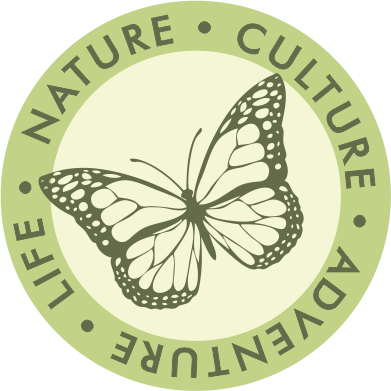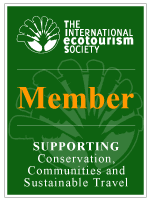Guatemala Ecotours
Guatemala is a land of contrasts from modern cities to isolated mountain villages. The country is culturally influenced by its ancient traditions and beliefs. The people still wear traditional hand-woven, embroidered clothing. Shamans and magic are still prominent in daily life and melded with Catholicism. Markets dot towns and villages offering an intriguing insight into the Maya culture. Amazing Mayan temples scatter the countryside with Tikal being the most famous. Listen for the raucous call of howler monkeys or follow a birder’s trail in El Peten reserves. Hike volcanoes, bike valleys, kayak one of the most beautiful lakes in the world or zip through jungle canopy. Welcome to Guatemala!
Guatemalan Magic
Day 1: Arrive Antigua
You are met at the Guatemala City airport and transferred to Antigua, about an hour drive. Remainder of the day at your leisure.
Founded in the sixteenth century, Antigua is a cosmopolitan destination with a rich colonial past. Its cobblestone streets are lined with pretty, pastel-hued homes, luxe boutique hotels, and an exceptional selection of smart restaurants and shops. A UNESCO World Heritage Site since 1979, this city of 35,000 people sits in valley between coffee farms, indigenous villages, and three imposing volcanoes. At the heart of town is the parque central, a European-style plaza busy with shoe-shiners, ice cream vendors, families, and tourists. During its architectural peak, Antigua was home to dozens of colonial monuments, churches, and monasteries, but an earthquake in 1773 damaged or reduced most to rubble. Efforts were made to rebuild and restore but many gorgeous relics and ruins remain.
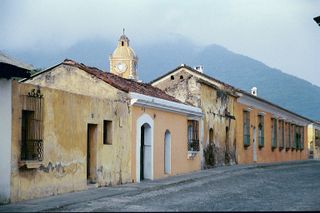
Day 2: Coffee and History
This morning travel to the small town of San Miguel Escobar where you meet your local guide from De La Gente (DLG). DLG is a charity working to support small independent coffee producers and promotes environmentally responsible agriculture in Guatemala. On this tour you visit some of the families supported by this organization. You have the option of working side-by- side with these small coffee farmers in their daily coffee processing. Depending on the season you may pick, pulp, ferment, wash, dry, trilla, sort or grade the coffee. End your experience by
roasting coffee over an open fire and grinding by hand on a grindstone before sampling your handiwork. Coffee season is Nov to Mar.
Return to Antigua for lunch (not included).
In the afternoon meet your guide to begin a half-day walking tour of Antigua. Your tour covers the cultural, historical and social highlights of this colonial city with a behind-the- scenes look at some of the many ruined churches, convents, and cathedrals. Visit Iglesia San Francisco, the Cathedral and La Merced Church. This tour is flexible and if you have specific sites that you wish to see please notify your guide. (B)
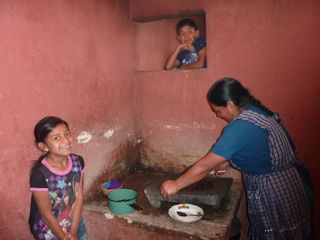
Day 3: Lake Atitlan
Today depart Antigua and journey to Lake Atitlan, renowned as one of the most beautiful lakes in the world
En-route stop in Comalapa, known for the mural depicting major events in Guatemala’s history and painted by the town’s school children. From here you visit some local painters who continue the tradition of naïve painting, a joyfull palette of colours used to portray the artists' subjects. Finally visit the wonderful authentic market of Comalapa to see the local people go about their daily life buying produce and goods.
After lunch at a local restaurant, head to the Mayan ruins of Iximiche. Iximiche contains four plazas, several large temples and a well-preserved ball court. As this is still a Mayan ceremonial site, you may see locals or even a shaman lighting candles and making offerings of tobacco and alcohol.
End your journey at your hotel on Lake Atitlan. (B,L)
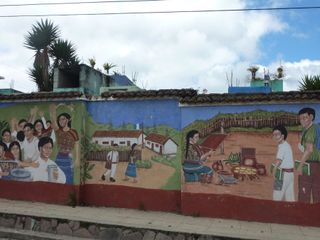
Day 4: Lake Atitlan
Visit the village of San Juan La Laguna and a local textile cooperative. Here learn about the back strap loom and how they use natural dyes. You also visit the home and workshop of local naif painters.
Board a boat and travel to Santiago. Enjoy lunch in a local restaurant.
After lunch you walk with your guide to find the house where the Maya God Maximon is living. Each year a different "brotherhood" has the privilege of taking care of their God so his location changes. You may see a shaman performing rituals for the locals.
Continue your guided tour of Santiago. Visit the local church with its integration of Catholicism and Mayan beliefs. Learn about the distinctive textiles and primitive art of Santiago. (B,L)
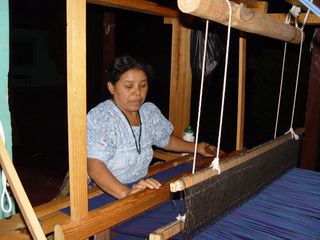
Day 5: Chichicastenagno and El Peten
Today travel from Lake Atitlan to Chichicastenagno or “Chichi” as it is known locally. With your guide you will explore this famous market filled with local fruits, vegetables, everyday items, textiles, and wooden and ceramic crafts. Visit the atmospheric St. Tomas Church where the Maya people come to burn incense and practise other Maya rituals. Or you can hike up the hill to the Pascual Abaj ritual site to see if a local shaman is performing rituals.
Enjoy lunch at a local restaurant.
When you are ready your drive continues to the Guatemala City airport in time for your flight to Flores and Tikal. (B,L)
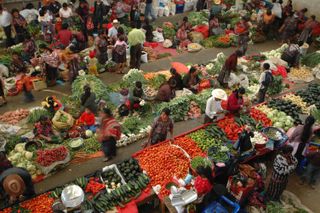
Day 6: El Peten and Yaxha National Park
Although it covers nearly one-third of the country, El Petén is Guatemala's most sparsely populated department. Here, parrots and monkeys far outnumber people, and the crumbling ruins of the ancient Mayas stand in for modern cities. A large tract of El Peten belongs to the Maya Biosphere Reserve, a wildlife haven that stretches from Belize through Guatemala to Mexico. The Tikal archaeological site is the department's biggest draw, though it's certainly not the only spot for ruins. Archaeology buffs will also enjoy Yaxha, Ceibal, Aguateca, and Uaxactún (you can camp at the latter). El Peten's main towns include Flores and El Remate; both provide easy access to Tikal.
Take a guided tour of Yaxha National Park, a lesser visited Maya ceremonial site. Set atop a hill overlooking two scenic lakes this is a particularly picturesque site. Temple 216 in the East Acropolis towers above the site and provides magnificent panoramic views of the surrounding landscape. At sunset you enjoy sunset snacks and wine at the shore of Lake Yaxha and cruise the lagoon in a small vessel before returning to their hotel. (B,L, S)
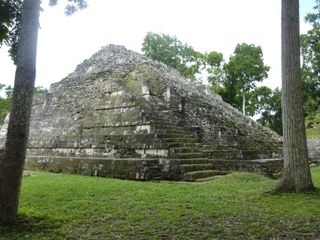
Day 7: Tikal and Guatemala City
Today you take a private tour of Tikal National Park. Tikal National Park consists of some 3,000 ancient structures rising from the rainforest floor. Not only will you enjoy a fascinating tour of this impressive UNESCO World Heritage Site, but you also experience the sights and sounds of tropical birds and animals, including howler and spider monkeys, that live in the jungle canopy.
Enjoy lunch at a local restaurant.
Transfer to the Flores airport in time for your flight to Guatemala City. (B)
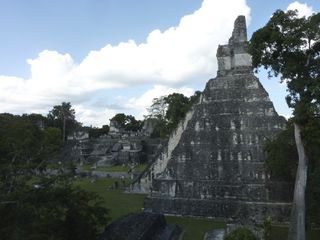
Day 8: Departure
Today transfer to the Guatemala City airport in time for your flight home. (B)
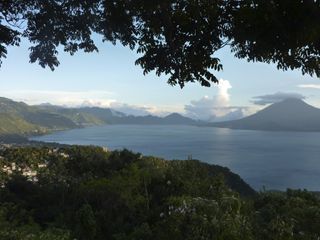
Tour Information
Tour Length: Tour Length: 8 days / 7 nights
Departures: Daily
Minimum Number of People: 2 based on Double Occupancy
Guatemalan Magic Includes:
- All ground transfers as noted in the itinerary
- 7 nights accommodation
- Meals per itinerary (B= Breakfast, L=Lunch and D=Dinner)
- Excursions, activities, and entrance fees as noted in the itinerary
- English-speaking guide on excursions and activities
Guatemalan Magic Doesn’t Include:
- International flight
- Departure tax if applicable
- Domestic Flights
- Travel Insurance
- Pre- or post-tour accommodation
- Meals not included in the itinerary
- Alcoholic and Non-alcoholic beverages
- Excursions, activities, and entrance fees not included in the itinerary
- Gratuities to guides and driver
- Personal items
Guatemala Highland Markets
Day 1: Arrive Antigua
You are met at the Guatemala City airport and transferred to Antigua, about an hour drive. Remainder of the day at your leisure.
Founded in the sixteenth century, Antigua is a cosmopolitan destination with a rich colonial past. Its cobblestone streets are lined with pretty, pastel-hued homes, luxe boutique hotels, and an exceptional selection of smart restaurants and shops. A UNESCO World Heritage Site since 1979, this city of 35,000 people sits in valley between coffee farms, indigenous villages, and three imposing volcanoes. At the heart of town is the parque central, a European-style plaza busy with shoe-shiners, ice cream vendors, families, and tourists. During its architectural peak, Antigua was home to dozens of colonial monuments, churches, and monasteries, but an earthquake in 1773 damaged or reduced most to rubble. Efforts were made to rebuild and restore but many gorgeous relics and ruins remain.
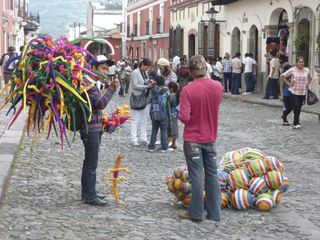
Day 2: Antigua
This morning you visit the local villages that surround Antigua to learn about local culture and history.
You start by driving up to the mountain town of Santa Maria, where many women still wear the traditional Mayan dress. You then venture down into the towns of San Pedro and Ciudad Vieja to visit colonial sights and see local village living before reaching the town of San Antonio, where you visit a women's textile cooperative and see how the beautiful and intricate Guatemalan textiles are made. Along the way you
stop at a Macadamia nut farm, where you have a chance to try a variety of products produced from the nuts. This tour is flexible and you should feel free to let your guide know if there are specific places they would like to visit.
Today, your guide takes you on a tour of Antigua's street food hot spots, where you get to taste some of Guatemala's most authentic cuisine. These are the places where long lines of locals are a fixture and for good reason: the food served is delicious and well-prepared. Items you might try include chuchitos (the Guatemalan take on a tamale), pupusas (cheese-filled corn tortillas), rellenitas (plantain dough that's filled with beans and then fried), and even pigs' feet. You learn the cultural and historic significance of the eats on offer and visit Antigua's bustling market to explore the colourful array of ingredients used in Guatemalan cuisine. (Please note that this tour is for more adventurous eaters.) (B)
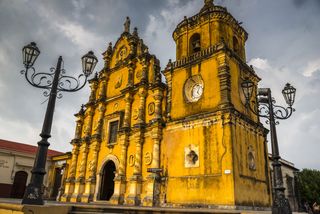
Day 3: Coffee and Iron
De La Gente (DLG) is a charity working to support small independent coffee producers and promoting environmentally responsible agriculture in Guatemala. This tour takes guests to visit some of the families supported by this organization. You have the option of working side-by- side with these small coffee farmers in their daily coffee processing. Depending on the season you may pick, pulp, ferment, wash, dry, trilla, sort or grade the coffee. End your experience by roasting coffee over an open fire and grinding by hand on a grindstone before sampling your handiwork. Coffee season is Nov to Mar.
After the coffee tour guests have a simple, traditional meal in a local home before transferring to the village of San Juan El Obispo to meet ironwork expert Carlos.
Carlos hosts visitors in his workshop, teaching the art of turning steel into a garden decoration or wall hanging in the form of critters, leaves, owls, and the like. At the end of the trip, you have a one-of- a-kind piece of art. Carlos tells the story of his family of metalworkers and how he turned his skill into an art form. He demonstrates the skills of his trade and teaches you how to make your own iguana, butterfly or candle holder. (B,L)
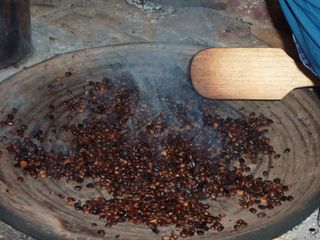
Day 4: Comalapa and Quetzaltenagno
Today depart Antigua and journey to Quetzaltenango, also known as Xela.
En-route stop in Comalapa, known for the mural depicting major events in Guatemala’s history and painted by the town’s school children. From here you visit some local painters who continue the tradition of naïve painting, a joyfull palette of colours used to portray the artists' subjects. Finally visit the wonderful authentic market of Comalapa to see the local people go about their daily life buying produce and goods.
Quetzaltenango feels less like Guatemala's second-largest city (which it is) and more like a university town, owing to its myriad colleges, universities, and Spanish language schools. It's home to a colonial-modern mix of cobblestone streets, pastel-hued houses, and busy street markets, as well as coffee shops, bars, glitzy malls, and restaurants. Its historic zone, with its impressive park and a border of stately buildings, is worth a look. Xela, as it is known, sits in a rugged, agricultural valley that's dotted by a handful of K’iche’ Maya villages; visit San Francisco El Alto's bustling Friday market to see the livestock for sale. Just outside the city, you'll also find hot springs and volcanoes.
Keep in mind that Xela is a highland city and gets chilly at night. Bring a sweater. (B,L)
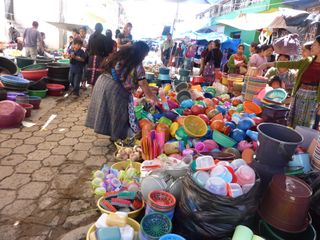
Day 5: Almolonga, Zunil & Fuentes Georginas
Today visit the small towns of Almolonga and Zunil and the natural hot springs, Fuentes Georginas.
Almolonga is known as "the garden of Central America". It's renowned for the gorgeous carrots, radishes, cabbages, and other vegetables it produces, most of which are exported to El Salvador. You visit the town's bustling produce market to check out the veggies and the local ropa típica (traditional dress), which is about as
vibrantly coloured as the produce on display.
Zunil, another agricultural town, is located in a beautiful, fertile valley flanked by mountains. Zunil is one of a handful of Guatemalan towns that still worships Maximón, an idol to whom locals offer gifts of cigarettes, alcohol, and colourful candles. His effigy is housed by a different member of the local cofradía (religious brotherhood) each year. While in Zunil, you visit Maximón as well as the town's striking Catholic Church, the local cemetery, and a weaving cooperative where items like huipiles (elaborately embroidered women's tunics) are made.
After lunch, you take the scenic route along the slopes of Zunil volcano (the views of nearby Santa María volcano are amazing) to Fuentes Georginas, a handful of pools fed naturally by hot sulfur springs. Relax in the thermal waters or simply enjoy the cool, lush setting. Afterwards, you return to Quetzaltenango. (B,L)
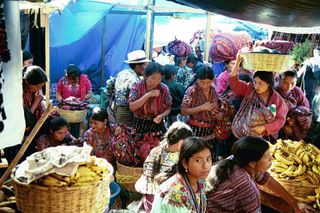
Day 6: San Andres Xecul and Homestay
San Andres Xecul is known for its unusual church. Painted a vibrant yellow, it has a façade depicting saints, animals, vines, and flowers; there's no other church in Guatemala quite like it. After visiting the church, you walk up through town to a smaller, less ornate replica of the church, alongside of which you find ceremonial grounds where locals perform Mayan rituals. From here, you can also enjoy a spectacular view of the surrounding valley and pine forests.
In Toto, located deep in the beautiful Maya highlands, discover a variety of handicrafts which this region is so well known. Stops along the way may include a visit with Don Miguel Hernández, who uses giant wood looms to make lovely, colourful textiles, or to a ceramics workshop where clay plates are handcrafted on pottery wheels and crushed glass is used to make lead-free paint. You may also visit a local family who produces boxes for traditional sweets sold in markets.
Tonight you stay with a local family and immerse yourself in the local culture. (B,L,D)
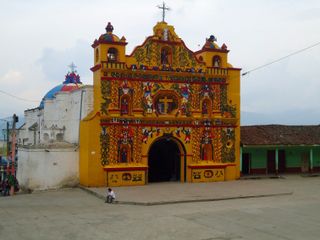
Day 7: San Francisco Market and Huehuetenango
An early morning for Huehuetenango, about a 2-3 hour drive from Quetzaltenango.
En-route stop at the chilly, highland town of San Francisco El Alto. On Fridays, the town hosts one of the largest and most authentic markets in Guatemala and is particularly well known for the array of livestock that it sells; you see pigs, cows, sheep, horses, mules, chickens, and other animals. (It's a fascinating scene from a cultural perspective, but note that it can be somewhat unsettling as animals are not always cared for according to Western standards.) Check out the myriad textiles on offer; you see everything from traditional fabrics and second-hand offerings to giant bolts of cloth and baskets full of thread. When you're ready to leave, you continue to Huehuetenango.
If giant mountains, steep ravines, and coffee-covered hillsides sound enticing, you're bound to enjoy Huehuetenango, one of Guatemala's westernmost departments. Home to the highest peaks of the Sierra de los Cuchumatanes, Huehue is known for its unique villages, natural attractions, and coffee (which is considered to be some of Guatemala's finest). One of Huehue's most interesting spots is Todos Santos, a chilly, isolated Mam Maya town famous for its colourful customs and clothing. A highlight of Huehue's many natural attractions includes the Laguna Magdalena, a remote lake with beautiful emerald waters. (B,D)
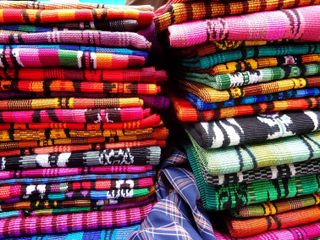
Day 8: Todos Santos Market
Begin your three hour journey deep into the Cuchumatanes mountains of Huehuetenango to visit Todos Santos, a Mam Mayan town located 2,500 meters above sea level. Todos Santos isolation has helped it maintain many of its traditional customs. Ropa típica (typical clothing) is the norm, with men donning the most striking outfits, red-and- white striped pants, striped shirts with embroidered collars, and straw hats; women wear vibrant purple huipiles (embroidered tunics). On Saturdays, you'll find a lively market with produce and regional handicrafts. In addition to its reputation for being traditional, Todos Santos is also well known for the festivities it hosts on and around All Saints Day ("Todos Santos" translates to "all saints"); a highlight is the horse race that takes place on November 1st. Please note that while todosanteros are quite friendly, they do not allow visitors to take photographs. (B,L,D)
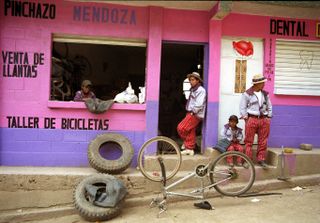
Day 9: Nebaj
Located in the Cuchumatanes mountains, the town of Nebaj is part of the Ixil Triangle, an isolated but stunning part of the country that also comprises the villages of San Juan Cotzal and Chajul, as well as a handful of outlying hamlets. A region that once felt the full force of the Guatemalan civil war, Nebaj and the Ixil Triangle are quiet destinations today where locals still adhere to traditional ways of life. Most men are farmers, while most women are weavers. Ixil, the local Mayan dialect, is the primary language spoken. Nebaj is the Ixil Triangle's largest town. Based in a spectacular valley-- with great views and hiking-- it comprises quaint homes, cobblestone streets, a pretty, whitewashed church, and a backdrop of towering mountains. Be sure to check out the local weavings sold in stalls near the church; Nebaj produces incredible textiles. (B,L)
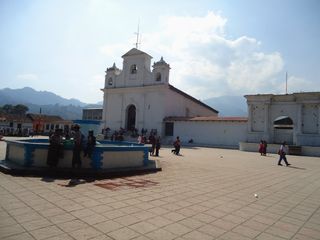
Day 10: Ixil Triangle
Today, you’ll explore the villages of the Ixil Triangle. You visit local churches, plazas, and markets and get a close-up look at local life. (Listen for Ixil, the region’s Mayan dialect.) Be prepared for scenic views and a backdrop of towering mountains. Some moderate hiking may be included. (B,L)
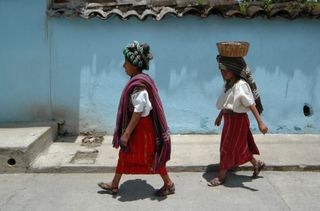
Day 11: Lake Atitlan
Today is a long driving day, about 5-6 hours from Ixil Triangle to Lake Atitlan.
Surrounded by rugged hills, a trio of towering volcanoes, and a handful of small villages, it's easy to wax poetic about Lake Atitlan. Located in the Guatemalan highlands, the lake was formed more than 80,000 years ago during a violent volcanic eruption. Tz'utujil and Kaqchiquel Mayas have plied its shores for centuries and continue to do so today, wearing vibrant traditional clothing and practicing age-old Maya customs, particularly in towns like Santiago Atitlán and Santa Catarina Palopó. Panajachel is the lake's main hub. From here, boats depart regularly for destinations like San Juan La Laguna, which is known for its hand-woven, naturally dyed textiles, and San Pedro, where intrepid visitors can summit a 3,020-meter volcano. The area also offers great opportunities to kayak, bike, and zip-line. (B)
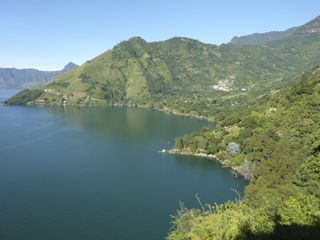
Day 12: Lake Atitlan
Visit the village of San Juan La Laguna and a local textile cooperative. Here learn about the back strap loom and how they use natural dyes. You also visit the home and workshop of local naif painters.
Board a boat and travel to Santiago. Enjoy lunch in a local restaurant.
After lunch you walk with your guide to find the house where the Maya God Maximon is living. Each year a different "brotherhood" has the privilege of taking care of their God so his location changes. You may see a shaman performing rituals for the locals.
Continue your guided tour of Santiago. Visit the local church with its integration of Catholicism and Mayan beliefs. Learn about the distinctive textiles and primitive art of Santiago. (B,L)
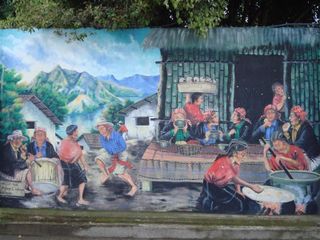
Day 13: Chichicastenagno and Antigua
Today travel to Chichicastenagno or “Chichi” as it is known locally. With your guide you explore this famous market filled with local fruits, vegetables, everyday items, textiles, and wooden and ceramic crafts. Visit the atmospheric St. Tomas Church where the Maya people come to burn incense and practise other Maya rituals. Or you can hike up the hill to the Pascual Abaj ritual site to see if a local shaman is performing rituals. (B)
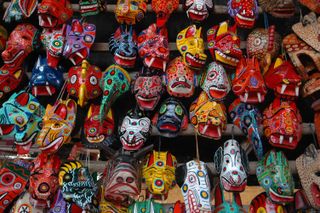
Day 14: Departure
Today transfer from Antigua to Guatemala City airport in time for your flight home. (B)
Tour Information
Tour Length: 14 days / 13 nights
Departures: Daily
Minimum Number of People: 2 based on Double Occupancy
Guatemala Highland Markets Includes:
- All ground transfers as noted in the itinerary
- 13 nights accommodation
- Meals per itinerary (B= Breakfast, L=Lunch and D=Dinner)
- Excursions, activities, and entrance fees as noted in the itinerary
- English-speaking guide on excursions and activities
Guatemala Highland Markets Doesn’t Include:
- International flight
- Departure tax if applicable
- Travel Insurance
- Pre- or post-tour accommodation
- Meals not included in the itinerary
- Alcoholic and Non-alcoholic beverages
- Excursions, activities, and entrance fees not included in the itinerary
- Gratuities to guides and driver
- Personal items
